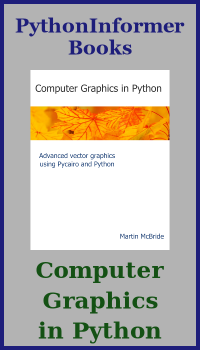King's dream fractal with generativepy
Categories: generativepy generative art

This article has been moved to my blog. Please refer to that article as it might be more up to date.
The king's dream fractal works in a similar way to the tinkerbell fractal. It is worth reading the tinkerbell fractal article, and the article on colorising tinkerbell before tackling the king's dream fractal in this article.
Kings dream formula
The fractal equations for king's dream are:
xnext = math.sin(A*x)+B*math.sin(A*y)
ynext = math.sin(C*x)+D*math.sin(C*y)
Where:
A = 2.879879
B = -0.765145
C = -0.966918
D = 0.744728
Here is the image it creates:

The code
Here is the full code for the image above:
from generativepy.bitmap import Scaler
from generativepy.nparray import make_nparray_data, save_nparray, load_nparray, make_npcolormap, apply_npcolormap, save_nparray_image
from generativepy.color import Color
import math
import numpy as np
MAX_COUNT = 10000000
A = 2.879879
B = -0.765145
C = -0.966918
D = 0.744728
def paint(image, pixel_width, pixel_height, frame_no, frame_count):
scaler = Scaler(pixel_width, pixel_height, width=4, startx=-2, starty=-2)
x = 2
y = 2
for i in range(MAX_COUNT):
x, y = math.sin(A*x)+B*math.sin(A*y), math.sin(C*x)+D*math.sin(C*y)
px, py = scaler.user_to_device(x, y)
image[py, px] += 1
def colorise(counts):
counts = np.reshape(counts, (counts.shape[0], counts.shape[1]))
power_counts = np.power(counts, 0.25)
maxcount = np.max(power_counts)
normalised_counts = (power_counts * 1023 / max(maxcount, 1)).astype(np.uint32)
colormap = make_npcolormap(1024, [Color('black'), Color('red'), Color('orange'), Color('yellow'), Color('white')])
outarray = np.zeros((counts.shape[0], counts.shape[1], 3), dtype=np.uint8)
apply_npcolormap(outarray, normalised_counts, colormap)
return outarray
data = make_nparray_data(paint, 600, 600, channels=1)
save_nparray("/tmp/temp.dat", data)
data = load_nparray("/tmp/temp.dat")
frame = colorise(data)
save_nparray_image('kings-dream.png', frame)
Variants
You can try different values of the constants. A and B need to be in the range -3 tp +3, while C and D need to be in the range -1.5 to +1.5, otherwise the values wil fly off to infinity rather than creating a pattern.
Be aware that most numbers you choose will not create pleasing patterns. You will need to experiment to find something that looks nice, and then do even more fine tuning to get something really nice.
You can also try varying the function. You can replace sin with cos in some or all of the equations. This will give different but similar patterns.
See the fractals article for a list of other fractal examples.
Related articles
Join the GraphicMaths/PythonInformer Newsletter
Sign up using this form to receive an email when new content is added to the graphpicmaths or pythoninformer websites:

Popular tags
2d arrays abstract data type and angle animation arc array arrays bar chart bar style behavioural pattern bezier curve built-in function callable object chain circle classes close closure cmyk colour combinations comparison operator context context manager conversion count creational pattern data science data types decorator design pattern device space dictionary drawing duck typing efficiency ellipse else encryption enumerate fill filter for loop formula function function composition function plot functools game development generativepy tutorial generator geometry gif global variable greyscale higher order function hsl html image image processing imagesurface immutable object in operator index inner function input installing integer iter iterable iterator itertools join l system lambda function latex len lerp line line plot line style linear gradient linspace list list comprehension logical operator lru_cache magic method mandelbrot mandelbrot set map marker style matplotlib monad mutability named parameter numeric python numpy object open operator optimisation optional parameter or pandas path pattern permutations pie chart pil pillow polygon pong positional parameter print product programming paradigms programming techniques pure function python standard library range recipes rectangle recursion regular polygon repeat rgb rotation roundrect scaling scatter plot scipy sector segment sequence setup shape singleton slicing sound spirograph sprite square str stream string stroke structural pattern symmetric encryption template tex text tinkerbell fractal transform translation transparency triangle truthy value tuple turtle unpacking user space vectorisation webserver website while loop zip zip_longest
